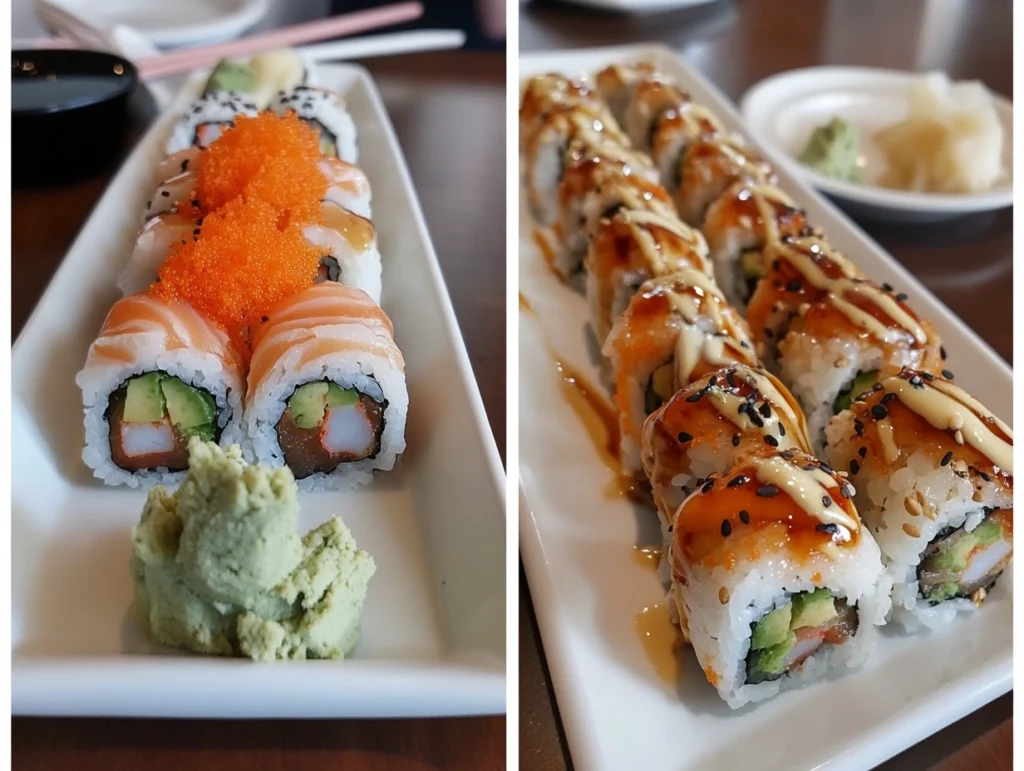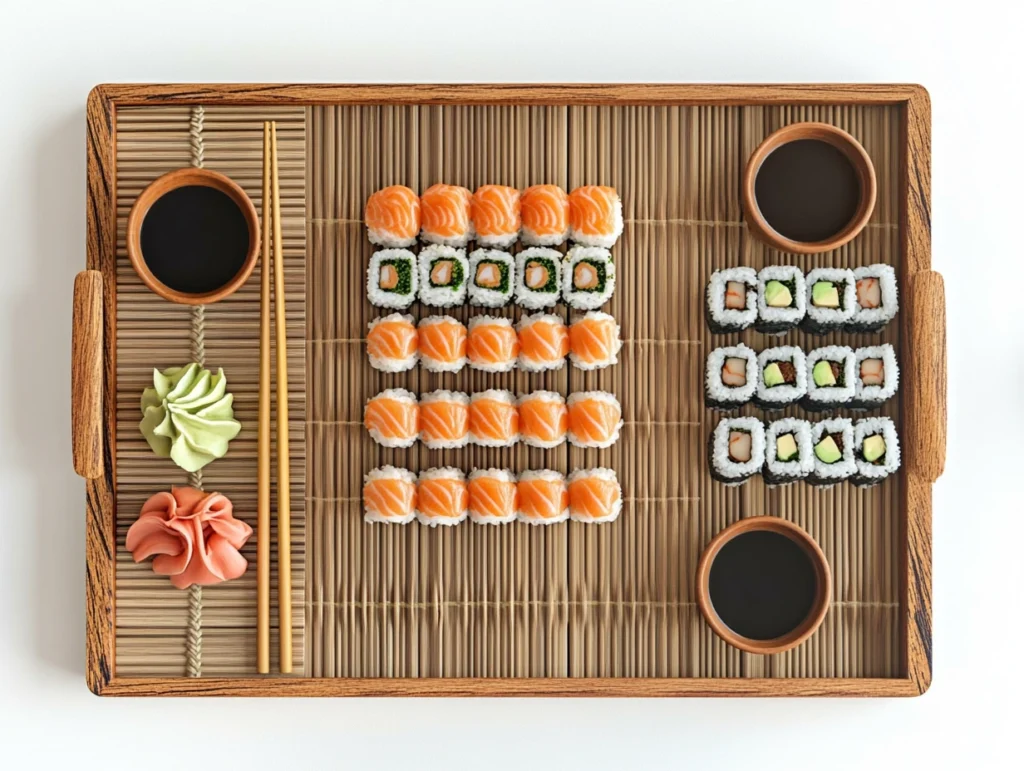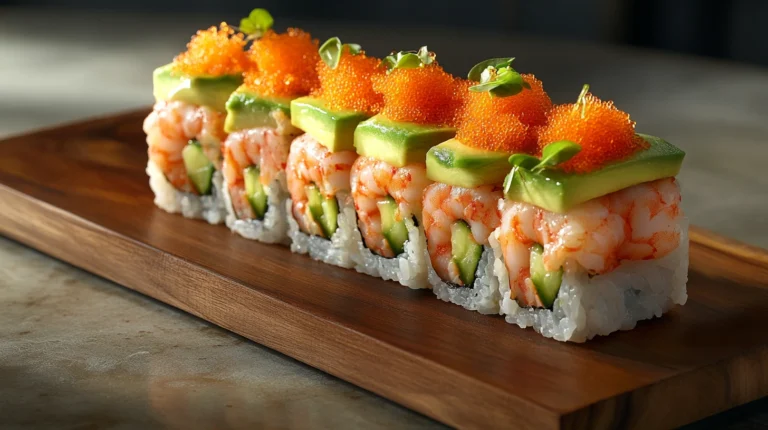Boston Roll vs. Philadelphia Roll—sushi rolls have become a global culinary sensation, delighting taste buds with their unique blend of textures and flavors. Among the many varieties, these two stand out as popular options on sushi menus worldwide. While both are delicious in their own right, they cater to distinct palates with their different ingredients and flavor profiles. This article dives deep into the differences between these rolls, comparing their origins, ingredients, tastes, and even how you can make them at home. Whether you’re a sushi novice or a seasoned connoisseur, you’ll find valuable insights to satisfy your curiosity—and maybe even your appetite!
Introduction to Sushi Rolls
The Global Popularity of Sushi Rolls
Sushi has transitioned from being a traditional Japanese delicacy to a modern global phenomenon. Rolls, or makizushi, are among the most creative adaptations of this beloved dish. With their filling variations and visual appeal, sushi rolls cater to diverse preferences across cultures.
What Defines a Sushi Roll?
At its core, a sushi roll consists of vinegared rice, seaweed (nori), and a combination of vegetables, seafood, or other fillings. Yet, the magic lies in how these elements are paired. The Boston Roll and Philadelphia Roll are great examples of fusion sushi, blending traditional techniques with modern ingredients like cream cheese or cooked shrimp.
What Is a Boston Roll?
The Boston Roll is a refreshing sushi roll made with cooked shrimp, cucumber, and avocado. Its signature topping—orange tobiko (fish roe)—adds a delightful pop of texture and a hint of saltiness. It’s lighter compared to many other rolls, making it a go-to for those who prefer subtle seafood flavors.
What Is a Philadelphia Roll?
On the flip side, the Philadelphia Roll is all about indulgence. Made with smoked salmon, cream cheese, and cucumber, it offers a rich, creamy texture with a smoky twist. It’s a classic example of fusion sushi, blending traditional Japanese techniques with American ingredients.
Why Compare the Boston Roll vs. Philadelphia Roll?
While both rolls cater to different flavor preferences, understanding their key differences can help sushi lovers make informed choices. Whether you prefer the light and fresh feel of the Boston Roll or the creamy, savory experience of the Philadelphia Roll, this comparison will guide you toward your ideal sushi experience.
Detailed Ingredient Comparison
Ingredients in a Boston Roll
The Boston Roll is celebrated for its light and refreshing flavor profile, crafted using a selection of fresh, simple ingredients:
- Cooked Shrimp: Unlike many sushi rolls that feature raw fish, the Boston Roll opts for cooked shrimp, delivering a mild sweetness and tender bite.
- Cucumber: Provides a crisp, refreshing crunch that balances the softness of the shrimp.
- Avocado: Adds a creamy, buttery richness, enhancing the overall texture.
- Tobiko (Fish Roe): This bright orange garnish not only makes the roll visually stunning but also offers a subtle salty flavor and a delightful popping texture.
These components combine to create a roll that feels light and satisfying, making it ideal for those who prefer gentler seafood flavors.
Ingredients in a Philadelphia Roll
In contrast, the Philadelphia Roll takes a bolder approach, combining rich and creamy textures with smoky and savory flavors. Its primary ingredients are:
- Smoked Salmon: The star of this roll, smoked salmon contributes a salty, smoky depth that sets it apart.
- Cream Cheese: A signature feature, cream cheese adds a creamy and slightly tangy element that pairs beautifully with the salmon.
- Cucumber: Adds a refreshing crunch to balance the creaminess and smokiness of the other ingredients.
- Optional Avocado: In some variations, avocado is included to amplify the roll’s creaminess further.
The Philadelphia Roll delivers a fusion of flavors that cater to those seeking a more indulgent sushi experience.
How Do the Ingredients Compare?
The Boston Roll leans toward clean and crisp flavors, while the Philadelphia Roll embraces bold and decadent ones. If you enjoy light, refreshing bites, the Boston Roll is your match. Conversely, the Philadelphia Roll offers a rich and luxurious experience for those craving heartier flavors.
Ingredient Versatility and Customization
Both rolls are highly adaptable to different dietary preferences. For instance:
- Vegetarians can swap out shrimp or salmon for tofu or extra vegetables.
- Health-conscious diners may opt for reduced cream cheese in the Philadelphia Roll to cut down on calories.
Distinct Flavor Profiles and Textures
Flavor Profile of a Boston Roll
The Boston Roll is all about subtlety and balance. Its flavor profile highlights:
- Light and Fresh Notes: The combination of cooked shrimp and cucumber creates a refreshing base, perfect for those who enjoy milder flavors.
- Creamy Undertones: Avocado adds a gentle creaminess that ties the roll together without overpowering its delicate taste.
- A Hint of Saltiness: Tobiko, with its mild briny flavor, enhances the overall taste without being overwhelming.
This roll is an excellent choice for those who appreciate sushi with understated, natural flavors that don’t rely on heavy sauces or bold ingredients.
Flavor Profile of a Philadelphia Roll
In contrast, the Philadelphia Roll leans into indulgence, offering:
- Rich and Smoky Tones: Smoked salmon delivers a salty, smoky depth that’s front and center in every bite.
- Tangy Creaminess: Cream cheese provides a luscious, tangy counterpoint to the salmon, creating a rich and satisfying taste.
- Refreshing Crunch: Cucumber offers a crisp texture that cuts through the creaminess, adding balance to the roll.
The Philadelphia Roll is a go-to for those who enjoy bold, fusion-style sushi with luxurious, Western-inspired flavors.
Comparing Textures
Texture plays a crucial role in the dining experience, and these two rolls couldn’t be more different:
- Boston Roll: The combination of cooked shrimp, crisp cucumber, and creamy avocado creates a smooth yet refreshing texture with every bite.
- Philadelphia Roll: Smoked salmon and cream cheese dominate the Philadelphia Roll, making it softer and more indulgent, with the cucumber adding a necessary crunch for contrast.
Which Roll Matches Your Taste Preferences?
If you enjoy clean, fresh flavors with a bit of crunch, the Boston Roll is likely to satisfy your palate. On the other hand, if you’re in the mood for something creamy and smoky with a touch of fusion, the Philadelphia Roll is an ideal pick.
Cultural and Regional Influences

Regional Influence on the Boston Roll
The Boston Roll is a shining example of how regional flavors can influence traditional dishes. Rooted in the coastal regions of New England, this roll emphasizes the local love for seafood, particularly shrimp. The inclusion of cooked shrimp instead of raw fish reflects the American palate’s preference for milder and safer seafood options.
Additionally, its refreshing ingredients like cucumber and avocado align with the global trend of creating lighter, health-conscious sushi rolls. While not a traditional Japanese roll, the Boston Roll has found its niche in sushi bars across the United States, thanks to its approachable flavor and visual appeal.
Regional Influence on the Philadelphia Roll
The Philadelphia Roll takes inspiration from American comfort foods. Originating in the United States, its use of cream cheese—a distinctly Western ingredient—sets it apart from more traditional sushi. The roll is named after Philadelphia, likely because of the city’s association with cream cheese brands, like the famous “Philadelphia Cream Cheese.”
The combination of smoked salmon and cream cheese creates a fusion dish that mirrors the smoky, creamy flavors often found in classic American cuisine. This innovative blend of Japanese technique and American ingredients has made the Philadelphia Roll a favorite for those new to sushi or looking for familiar tastes in their rolls.
How Cultural Fusion Shaped These Rolls
Both the Boston Roll and the Philadelphia Roll are products of cultural fusion, adapting Japanese culinary traditions to fit Western preferences.
- The Boston Roll aligns with a health-focused approach, celebrating the freshness of seafood and vegetables.
- The Philadelphia Roll showcases how bold, indulgent flavors can redefine sushi, making it more accessible to those unaccustomed to raw fish or traditional Japanese flavors.
Global Popularity and Regional Variations
Though these rolls originated in the U.S., their appeal has spread worldwide. Sushi chefs often tweak recipes to match local preferences, ensuring these rolls remain dynamic and versatile. For instance:
- In some regions, the Boston Roll might include lettuce for added crunch.
- The Philadelphia Roll may feature different smoked fish varieties depending on regional availability.
Perfect Pairings for Boston and Philadelphia Rolls
Pairings with the Boston Roll
The Boston Roll’s light and refreshing flavors make it versatile and easy to pair with complementary sides and drinks. Here’s how to enhance your dining experience:
- Side Dishes:
- Edamame: The natural saltiness of steamed edamame complements the mild sweetness of cooked shrimp.
- Miso Soup: A warm, umami-rich soup balances the crisp textures of cucumber and tobiko.
- Seaweed Salad: The tangy, nutty flavors of seaweed salad enhance the roll’s subtle taste.
- Dipping Sauces:
- Soy Sauce: Use sparingly to avoid overpowering the roll’s delicate flavors.
- Ponzu Sauce: A citrus-based sauce adds a zesty kick without overwhelming the shrimp.
Pairings with the Philadelphia Roll
The Philadelphia Roll’s bold, creamy, and smoky profile pairs well with rich and savory accompaniments:
- Side Dishes:
- Tempura: Crispy tempura offers a contrasting texture that complements the soft cream cheese and smoked salmon.
- Pickled Ginger: A palate cleanser between bites, allowing you to fully enjoy the roll’s flavors.
- Japanese Potato Salad: The creamy, savory nature of this salad harmonizes beautifully with the Philadelphia Roll.
- Dipping Sauces:
- Wasabi Soy Sauce: A touch of wasabi blended with soy sauce enhances the roll’s smoky flavors.
- Spicy Mayo: For an extra indulgent experience, drizzle some spicy mayo over the roll.
Best Drinks to Pair with Each Roll
While beverages are often tailored to personal preferences, the following non-alcoholic drinks work particularly well:
- Boston Roll: Green tea, sparkling water with a lemon twist, or cucumber-infused water highlight its fresh, clean flavors.
- Philadelphia Roll: Iced matcha latte, ginger tea, or a creamy soy milk drink pairs well with its rich, smoky profile.
Crafting the Ultimate Sushi Meal
For a well-rounded sushi experience, consider serving both rolls together. Start with the lighter Boston Roll to awaken the palate, then transition to the richer Philadelphia Roll for a satisfying finale. Pair them with versatile sides like miso soup or seaweed salad to complement both rolls without overwhelming their unique flavors.

FAQs About Boston Roll vs. Philadelphia Roll
What makes the Boston Roll and Philadelphia Roll different?
The key difference lies in their ingredients and flavor profiles. The Boston Roll features cooked shrimp, cucumber, and avocado, creating a light and refreshing taste. In contrast, the Philadelphia Roll is richer and creamier, with smoked salmon, cream cheese, and cucumber as its main components.
Which roll is healthier, Boston Roll or Philadelphia Roll?
Both rolls have health benefits, but the Boston Roll is often considered lighter due to its simpler ingredients and absence of cream cheese. The Philadelphia Roll is more indulgent with its creamy and smoked components, making it higher in calories and fat content.
Can vegetarians enjoy variations of these rolls?
Absolutely! Vegetarians can substitute shrimp in the Boston Roll with tofu or extra vegetables and replace smoked salmon in the Philadelphia Roll with plant-based alternatives. These adjustments maintain the rolls’ textures and flavors while catering to a vegetarian diet.
What sauces pair well with each roll?
For the Boston Roll, soy sauce or ponzu sauce enhances its delicate flavors. The Philadelphia Roll pairs well with wasabi soy sauce or spicy mayo to complement its rich and smoky profile.
Are Boston Roll and Philadelphia Roll gluten-free?
These rolls can be gluten-free if made with gluten-free soy sauce and if the tobiko (fish roe) in the Boston Roll does not contain added gluten. Always confirm ingredient details when ordering or preparing at home.
Which roll is better for sushi beginners?
The Boston Roll is an excellent choice for sushi beginners, thanks to its cooked shrimp and mild flavors. The Philadelphia Roll, with its creamy and smoky elements, may appeal more to those seeking a richer introduction to sushi.
Conclusion
In the vibrant world of sushi, the Boston Roll and Philadelphia Roll stand out for their distinct flavors and unique appeal. The Boston Roll captures light, fresh notes perfect for those seeking a subtle, refreshing sushi experience. Meanwhile, the Philadelphia Roll indulges the palate with creamy, smoky richness. Together, they exemplify the beautiful fusion of Japanese tradition and Western innovation.
Whether you’re a sushi purist or a fusion enthusiast, exploring these two rolls adds variety to your sushi journey. Next time you’re at a sushi bar—or trying your hand at homemade rolls—don’t hesitate to savor the best of both worlds.
Suggestions for Outbound Links
Outbound Links:
- Read about the nutritional benefits of sushi at Healthline’s Sushi Nutrition Guide.


1 thought on “Boston Roll vs. Philadelphia Roll: Key Differences Explained”
Comments are closed.